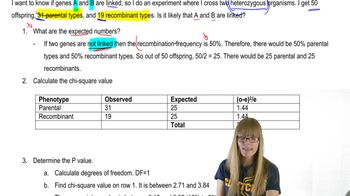Here are the essential concepts you must grasp in order to answer the question correctly.
Linkage
Linkage refers to the tendency of genes located close to each other on the same chromosome to be inherited together during meiosis. This phenomenon can be observed through genetic crosses and is crucial for understanding inheritance patterns. When genes are linked, the recombination frequency between them is lower than expected, allowing researchers to infer their proximity on the chromosome.
Recommended video:
Chromosomal Mapping
Chromosomal mapping is the process of determining the relative positions of genes on a chromosome. This is often achieved through techniques such as linkage analysis, which uses the frequency of recombination between genes to estimate distances on the chromosome. The resulting genetic maps help in understanding gene interactions and the organization of genetic material.
Recommended video:
Genetic Markers
Genetic markers are specific sequences in the genome that can be used to identify individuals or species and track inheritance patterns. In cases where direct matings cannot be performed, such as in humans, researchers utilize genetic markers to study linkage and map genes. These markers can include single nucleotide polymorphisms (SNPs) or microsatellites, which provide valuable information about genetic relationships and traits.
Recommended video:
 Verified step by step guidance
Verified step by step guidance Verified video answer for a similar problem:
Verified video answer for a similar problem:

